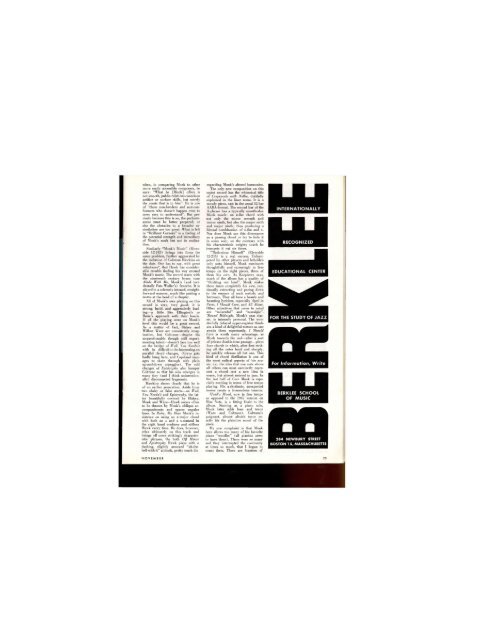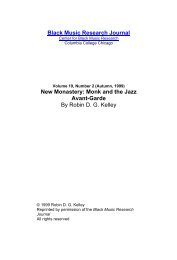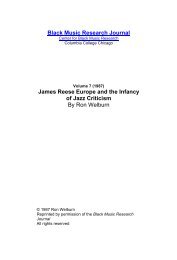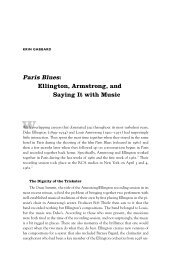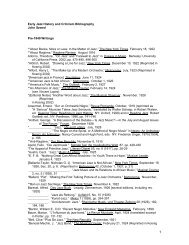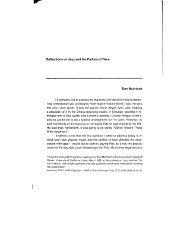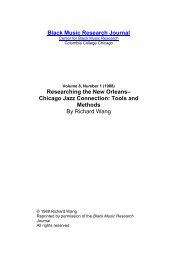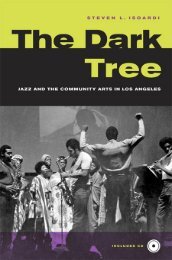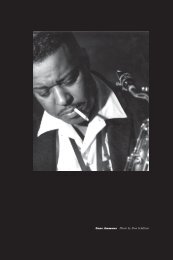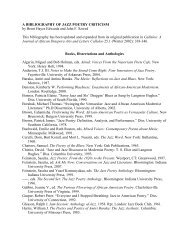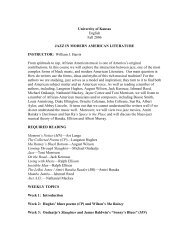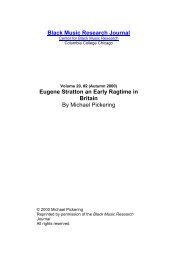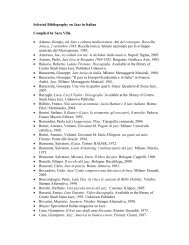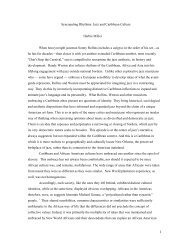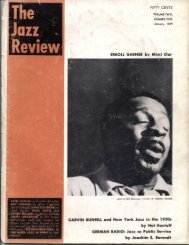The Jazz Review - Jazz Studies Online
The Jazz Review - Jazz Studies Online
The Jazz Review - Jazz Studies Online
Create successful ePaper yourself
Turn your PDF publications into a flip-book with our unique Google optimized e-Paper software.
when, in comparing Monk to other<br />
more easily accessible composers, he<br />
says: "What he [Monk] offers is<br />
not smooth, public-relations-conscious<br />
artifice or surface skills, but merely<br />
the music that is in him". He is one<br />
of "those non-benders and non-conformers<br />
who doesn't happen even to<br />
seem easy to understand". But precisely<br />
because this is so, the performances<br />
must be better prepared, or<br />
else the obstacles to a broader assimilation<br />
are too great. What is left<br />
in "Brilliant Corners" is a feeling of<br />
the potential strength and immediacy<br />
of Monk's work but not its realization.<br />
Similarly "Monk's Music" (Riverside<br />
12-242) brings into focus the<br />
same problem, further aggravated by<br />
the inclusion of Coleman Hawkins on<br />
the date. One has to say, with great<br />
reluctance", that Hawk has considerable<br />
trouble finding his way around<br />
Monk's music. <strong>The</strong> record starts with<br />
the nineteenth century hymn tune<br />
Abide With Me, Monk's (and incidentally<br />
Fats Waller's) favorite, ft is<br />
nlaved in a solemnlv intoned straightforward<br />
manner much like outtinL a<br />
motto at the head of a chapter.<br />
All of Monk's own playing on this<br />
record is very, very good; it is<br />
strong, lucid, and aggressively leading—a<br />
little like Ellington's or<br />
Basie's approach with their bands.<br />
If all the playing were on Monk's<br />
level this would be a great record.<br />
As a matter of fact, Blakey and<br />
Wilbur Ware are consistently imaginative<br />
but Coltrane—despite his<br />
unoues'tionable 'thoueh still experimenting<br />
talent-doesn't fare too well<br />
on the hrirW of Well Vnil Needn't<br />
with its diffirult to be interesting<br />
parallelI rhordI f f W ^<br />
hadlv hnn P here anf rnnetan^man<br />
ZZ t n L i e tCLkwftlT 3!u<br />
mT!JI r W ^ S l <strong>The</strong> SLA<br />
T^TTFZ^Z ll J if, J ~ r<br />
r X f l th a I h i <br />
coltrane so that h,: solo emerges m<br />
many tiny land 1 think un.ntentionally)<br />
disconnected fragments.<br />
Hawkins shows clearly that he is<br />
of an earlier generation. Aside from<br />
two shaky or false starts—on Well,<br />
You Needn't and Epistrophy, the latter<br />
beautifully covered by Blakey,<br />
Monk and Ware—Hawk seems often<br />
to be thrown by Monk's oblique accompaniments<br />
and sparse angular<br />
lines. In Ruby, My Dear Monk's insistence<br />
on using an E-maior chord<br />
with both an A. and a G-natural in<br />
the right hand confuses and stiffens<br />
Hawk everv time He does however<br />
relax ultimately on this track and<br />
hrinp-s off some etrikincrlv ehnraeter<br />
istC DhM«TO.hlth OfiMiMT<br />
and f l S v l w I v ! with a<br />
d«hi OUSL Tnnnverl "^h tL<br />
hell wfh it"1SdTpSty much dis"<br />
regarding Monk's altered harmonies.<br />
<strong>The</strong> only new composition on this<br />
septet record has the whimsical title<br />
of Crepescule with Nellie, dutifully<br />
explained in the liner notes. It is a<br />
moody piece, cast in the usual 32-bar<br />
AABA-format. <strong>The</strong> second bar of the<br />
A-phrase has a typically unorthodox<br />
Monk touch: an E-flat chord with<br />
not only the minor seventh and<br />
minor ninth, but also the major sixth<br />
and major ninth; thus producing a<br />
bitonal combination of E-flat and C.<br />
Nor does Monk use this dissonance<br />
as a passing chord or try to hide it<br />
in some way; on the contrary with<br />
his characteristic weighty touch he<br />
trumpets it out six times.<br />
"<strong>The</strong>lonious Himself" (Riverside<br />
12-235) is a real success. Unhampered<br />
by other players and beholden<br />
only unto himself, Monk ruminates<br />
thoughtfully and caressingly in free<br />
tempo on the eight pieces, three of<br />
them his own. As Keepnews says,<br />
much of the album has a quality of<br />
"thinking out loud". Monk makes<br />
these tunes completely his own c o n<br />
tinually extracting and paring down<br />
to the of each melody and<br />
harmonv <strong>The</strong>v all have a heautv and<br />
hiuntmfflvricsm esnechllv 4mil in<br />
ParV'/Should Care and All Alone<br />
Other adierHves that rome to mind<br />
are ''mournful" and "nostaleie"<br />
'KnnnA Wdnirht Monk'sown e as'<br />
W iTintenlTv nersonal <strong>The</strong> won"<br />
Xrf.llv ,fnner tijerthirrk<br />
are a.kind ot delightful torture as one<br />
awaits them expectantly / Mould<br />
Core is worth many rehear.ngs, as<br />
Monk towards the end-after a sort<br />
of private douhle-tmie passage—plays<br />
four chords in which, after first striking<br />
all the notes hard and sharply,<br />
he quickly releases all but one. This<br />
kind of chord distillation is one of<br />
the most radical aspects of his music,<br />
i.e., the idea that one note above<br />
all others car, most succinctly represent<br />
a chord—not a new idea in<br />
music, but almost untried in jazz. In<br />
the last half of Care Monk is especially<br />
exciting in terms of free tempo<br />
playing. His a-rhythmic, unexpected<br />
moves create a tremendous tension.<br />
Monk's Mood, now in free tempo<br />
as opposed to the 1947 version on<br />
Blue Note, is a fitting finale to the<br />
album. Starting as a piano solo,<br />
Monk later adds bass and tenor<br />
(Ware and Coltrane). Coltrane's<br />
poignant, almost altoish tenor eXactlv<br />
fits' the plaintive mood of the<br />
piece.<br />
My one complaint is that Monk<br />
here allows too many of his favorite<br />
piano "noodles" (all pianists seem<br />
to have them). <strong>The</strong>re were so many<br />
and they interrupted the continuity<br />
at times so much, that I began to<br />
count them. <strong>The</strong>re are fourteen of<br />
INTERNATIONALLY<br />
•<br />
RECOGNIZED<br />
•<br />
EDUCATIONAL CENTER<br />
For Information, Write<br />
BERKLEE SCHOOL<br />
OF MUSIC<br />
m m<br />
284 NEWBURY STREET<br />
BOSTON 1 5, MASSACHUSETTS


